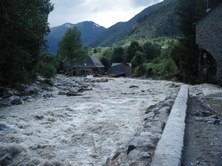David Pino coordinates the creation of the most complete catalog of floods in the peninsular Mediterranean slope over a thousand years
Oct 16, 2019
The 'MEDIFLOOD' project, coordinated by the department, has created the first archive that compiles, identifies and analyzes 14,500 cases of rain and river flooding in the Spanish Mediterranean watershed in a period of almost a millennium. The information provided by this catalog will allow to increase the forecast capacity of extreme weather events in order to design the most effective adaptation and response actions.
The last episodes of torrential rainfall in the Valencian Community, Murcia and Andalusia are common at this time of the year, according to historical records. The projections of climate models for a future marked by global warming indicate a growing rainfall irregularity, with more droughts, but at the same time an increase in torrential rainfall.
Analyzing the impact and complications that the increase in precipitation can cause is key to being able to perform a good public intervention and mitigate its effects. For this reason, it is necessary to have mechanisms for collecting, arranging and analyzing extreme weather events on a historical scale, which allow to reduce uncertainties and to plan the adaptation and response actions in a suitable way. This is the objective of the research, development and innovation project ‘MEDIFLOOD’, coordinated by the researcher David Pino and developed jointly with multidisciplinary teams from the University of Barcelona, the University of Lleida, the University of Murcia, the University of Alicante and the Meteorological Service of Catalonia. The project is funded by the Ministry of Economy and Competitiveness (now, Ministry of Economy and Business).
The unified classification and classification system of the 'MEDIFLOOD' project has managed to define 14,500 cases of flood and river flood, which consistently cover from November 3 of the year 1035 until July 31, 2019. This information has It allowed to identify, up to now, 3,980 episodes of flooding. The support material with all the details and references constitutes a thesaurus of 7,600 pages.
The collected data come not only from the materials available in the National Historical Flood Catalog (CNIH), the Ministry of the Interior, but also databases and reports from the different hydrographic basin authorities, as well as historiographic search work and compilation in documentary and bibliographical sources still unexplored in a high percentage.
Analysis of data
The database created shows that the Mediterranean slope of the Iberian Peninsula has suffered floods of varying intensity, some much more extreme than those recorded instrumentally. The behavior of the climate has generated more or less favorable moments in torrential rains, both in warm stages and in cold stages.
The rains that have produced the recent floods in the Valencian Community, Murcia and Andalusia have been high (with a maximum of 300 mm in 24 hours), but they are far from the maximum registered in 24 hours in Oliva (Valencia) on November 3 1987 - of 817 mm (official maximum registered in Spain) -. Regarding the maximum intensities that have been measured in the current episode, about 150 mm / h, exceed 129.9 mm / h officially measured in Santa Cruz de Tenerife on March 31, 2012.With these extreme rain intensities, the hydrological response is very sudden, in one or two hours, as well as voluminous, so that extremely dangerous flash flood flows are generated, called flash-floods. Despite being serious, these floods are of the same magnitude or smaller than some episodes recorded in November of 1617 on almost all the Mediterranean side, in October of 1787 in the Ebro basin or in May of 1853 in the rivers Cinca , Segre and lower course of the Ebro.
In order to face up to the challenges of the future posed by this reality, so important is to study the climatic processes as well as the effects of human action on the territory. In this sense, the project has analyzed the adaptation of the population to this climatology with often adverse events. According to the research, the main change is given in the way in which the territory has been occupied and in the consequent impact, transformations that over the last decades have negatively influenced the behavior of river systems. It has been detected, for example, a substantial increase in rainfall, or in situ, often linked to drainage problems, which cause damages and damage to areas that had not previously been flooded.
As David Pino points out, "the catalog will allow to evaluate the effects of human activities (urban growth, riverbed occupation, impact of public works, for example), in the presence of rain and river floods of different types." This will allow to develop proposals for a better management of the climatic risk, advancing in the reduction of exposure and vulnerability to the risk.
Climatic and social factors behind the Spanish Mediterranean flood event chronologies from documentary sources (14th–20th centuries)
M. Barriendos, S. Gil-GuiradoD. PinoJ. Tuset, A. Pérez-Morales, A. Alberola, J. Costa, J.C. Balasch, X. CastelltortJ. MazónJ.L.Ruiz-Bellet
Global and Planetary Change, Volume 182 (2019)
DOI: https://doi.org/10.1016/j.gloplacha.2019.102997

Share: